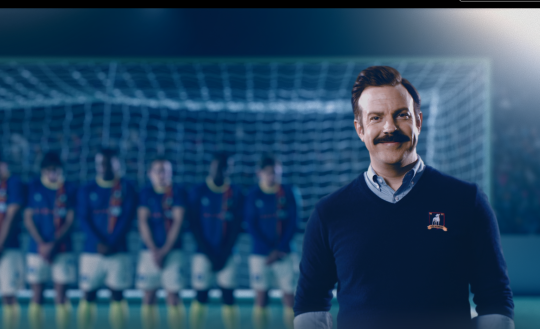Writing a biweekly column is a little like playing roulette. Sometimes the little white ball settles into its resting place under the right number: Bingo! I’m a winner! An idea takes shape and form and almost writes itself. I feel like I fell out of the lucky tree and hit every branch on the way down before landing in a pile of cash and Sour Patch candy.
Other times, Lady Luck and the muses of inspiration hide in the shadows just as the next unforgiving deadline marches ever closer. I’m in limbo — a great party game but not the ideal writing condition. The first sign of desperation? You guessed it: mixing my metaphors.
But I smell potential. As my momma never actually said, “Taking on a challenge is a lot like riding a horse, isn’t it? If you’re comfortable while you’re doing it, you’re probably doing it wrong.”
The fictional character Ted Lasso actually said that, quoting his even more fictional momma.

The past couple of weeks, I’ve been binging on Ted Lasso on Apple TV+, which we got to bridge the entertainment gap until the start of baseball season. Now, baseball is here and Season 3 of Lasso just dropped. Gotta live in the moment, which is a gift. I guess that’s why they call it the present.
Yes, I’m late to this pop culture party. I’m also right on time, because the Lasso character’s irrepressible optimism and Kansas-cute, life-giving affirmations are just what this doctor ordered. It’s all good in the hood. Marrying a recreational leisure activity with an occupational duty just as time is running out? Now that’s a pro move.
Distilling my considered observations that were charted watching the first season’s 12 episodes for a second time, I’ve easily identified eight certified fresh, five-star maxims for leadership in the home furnishings industry. Now that’s a combo! All we need is a medium drink!
And, because Lasso’s task is to coach in a sport he knows nothing about, in a far-off country, Lasso’s “lessons” are applicable in whatever leadership roles we find ourselves, from supplier to manufacturer to retailer and beyond. You’re gonna enjoy the heck out of this.
Lasso lesson No. 1: Don’t keep your eye on the ball.
If you have ever watched preschool children play soccer, you may have noticed their obsession with the ball. So focused on that 9-inch orb, heads down, eyes looking at their own feet, they often lose sight of where the goal net is, even of which direction they should be going. You likely know where this tip is going: Play the game, not the ball, by seeing the bigger picture. Good leaders keep their eyes on the horizon.
Lasso lesson No. 2: Be curious.
A wonderful scene toward the end of Season 1 has Lasso winning a game of darts in a pub, and in dramatic fashion. He punctuates his winning throws with a folksy story about being underestimated his entire life. Why was he so misjudged? Because his oppressors weren’t curious. Quoting Walt Whitman, Lasso schools his tormentor: “Be curious, not judgmental.” If they had been curious, they would have asked questions, like, “Are you any good at darts?” Good leaders ask good questions and a lot of questions.
Lasso lesson No. 3: Keep an intentionally open mind because insight and good ideas can come from almost anywhere.
Early in Season 1, the team’s trainer bashfully suggests a strategy that, of course, nets the team a goal. Lasso’s apparent lack of ego keeps him open to criticism, ideas and suggestions. When they work, he’s careful to give credit where credit is due. He’s refreshingly humble, but never a doormat. Good leaders are secure enough in themselves to humbly receive good ideas regardless of their source.
Lasso lesson No. 4: Forgive people.
My favorite scene so far features his manipulative, diabolical, undermining boss, the soccer club’s owner, finally coming clean about her erstwhile secret plan to use Ted to torpedo the organization. She was interested only in avenging her cheating ex-husband by ruining his football club.
Grieving over his own divorce, Lasso forgives immediately and completely. “It’s all good in the hood,” he says, and he means it. He preternaturally understands that forgiving frees the forgiver much more than the forgiven, who still has the guilt with which to deal. Lasso’s reflexive, loving mercy frees him to simply move on. A goldfish can only remember about 10 seconds. Be like a goldfish. Good leaders “FIDO” — fuhgettit and drive on!
Lasso lesson No. 5: Cultivate a sense of wonder and, in that wonder, perpetual joy.
In the first season’s third episode, Ted and his team captain visit a local primary school to build goodwill. His humility, sense of adventure and uncanny ability to be fully in the moment allow him to become just another kid on the playground. He has no fear of making a fool of himself, which he does with some frequency, but his sincerity and spontaneity invariably redeem the otherwise potentially embarrassing moments. It’s all part of the journey. Good leaders take risks.
Lasso lesson No. 6: Stay others-focused.
Ted very actively remembers people’s names, family histories, preferences and peeves, and even the smallest of details. He constantly thanks those around them for their contributions. “Appreciate you,” he says, even to the lowest-rung employees. A result of his genuine humility, Ted’s gratitude helps him to see everyone in his world as having value, and his reasoning seems to be that if he can believe in someone, that someone just might believe in him- or herself. Good leaders are good people.
Lasso lesson No. 7: Picking up on the theme of gratitude, Ted is so contagiously grateful to be in the position he is that his positivity is the rising tide that buoys all boats. He seems missionally directed to find things for which to be grateful, and he communicates this gratitude verbally, through tokens and gifts, with corny rites and rituals, and with a relentlessness that preempts pity and cynicism. Good leaders are grateful leaders.
Lasso lesson No. 8: Apologize.
Can you remember the last time you apologized? A real apology, not a non-apology apology that began with something like, “I’m sorry you feel . . .” After blowing up at his trainer, Ted forthrightly and sincerely apologizes for “not being my best self.” When my kids were growing up, I looked for opportunities to ask them for their forgiveness, which kept me on the lookout for ways I might be hurting their feelings or abusing my position and authority as Dad. You can guess the effect on an 8-year-old of being asked to forgive an adult. They did so immediately, eagerly and with a tenderness that, in a huge turnaround, modeled also for me how to forgive. Good leaders apologize.
So, there you have it. All that’s left is to stick the landing. You don’t like this list? Well, that’s like Woody Allen playing the clarinet. I don’t want to hear it! In fact, if we were together right now in the same room, I’d ask us to gather up for an “ussie” (that’s a selfie with more than one person in the shot). Smile!
Barbecue sauce!
Brian Carroll covered the international home furnishings industry for 15 years as a reporter, editor and photographer. He chairs the Department of Communication at Berry College in Northwest Georgia, where he has been a professor since 2003.


